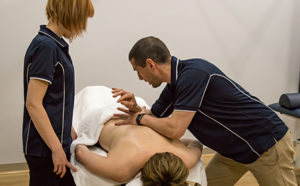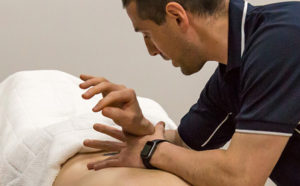The Top 10 Benefits of Remedial Massage
Do you often feel stressed? Do you suffer from aches and pains or constant niggling headaches? Do the demands of everyday life affect your physical and mental health? Well, you are not alone. In our fast-paced modern world where stress is high, work hours are long and we are increasingly time poor, the need to maintain our mental health and well-being has never been more important.
In Australia, health consciousness is on the rise. More and more people are turning to complementary medicines and are seeking combined conventional medical and holistic treatments to deal with a variety of physical, mental and emotional ailments with the aim of improving their general wellness. Therefore, it comes as no surprise that the alternative health therapy field in Australia is booming, contributing $4 billion to the economy annually (source: IBISWorld, 2018).
With massage therapists making up the largest professional group in the complementary healthcare sector, the demand for skilled therapists continues to rise. Given this, we thought it fitting to learn about the history of massage and popular massage techniques. As an added bonus, we look at the growing area of massage therapy in Australia to help educate you—our readers—about the top 5 benefits of remedial massage.
What is Remedial Massage?
Remedial massage is a complementary therapy that assists in rehabilitation, pain relief and injury management of musculoskeletal disorders and acute or chronic conditions. One of the primary goals of remedial massage is to locate and repair muscles that are damaged, tense, knotted or immobile, to aid in the body’s own healing process following injury and to promote relaxation and well-being.
During healing treatment, a remedial massage therapist uses various manual techniques to apply different pressure to the body, ranging from gentle and shallow (manipulation of the superficial muscle layers) to strong and deep (manipulation of deeper muscle layers as well as connective tissue).
The treatment techniques employed by remedial massage therapists include trigger point therapy, deep tissue massage, neuromuscular facilitation and myofascial techniques. These therapists are also skilled in conducting a specialised range of assessments to get a comprehensive view of their client’s issues and customise therapeutic treatment. For example, remedial massage therapists conduct Range of Motion testing (assesses joint movement, highlight limitations and indicate the types of tissue involved), Functional Tests (these help guide treatment plans based on the client’s history and the nature of their condition) and Postural Analysis (identify postural imbalances by evaluating the positioning of a client’s body) (source: Association of Massage Therapists).
Growth of Remedial Massage in Australia
One of the more popular techniques of massage that has experienced huge growth in Australia is remedial massage. Today, it is increasingly complementing traditional multidisciplinary approaches to general health care. What’s more, workplaces around the country and indeed around the world are recognising the health benefits of remedial massage. This has led to a growing trend of offering a complimentary massage service in the workplace. Global companies such as Google have instituted massage programs to promote overall well-being, which benefits both the employer and their employees alike. As a result, the development and professionalism of the massage industry have been strengthened, especially in the remedial massage area. This begs the question, what is remedial massage and how does it differ to other forms of massage?
What To Expect When You Visit A Remedial Massage Therapist
To get the most out of a remedial massage, it is important to discuss your reasons for making an appointment and talking to your massage therapist about your general health and any issues you may be experiencing. The therapist will then get you to lie on a massage table and cover you with a towel, exposing only the areas that they work on. After applying oils or creams, the remedial massage therapist will use a variety of techniques to work on problem areas.
Before and during your massage, it is important that you speak to your massage therapist about the level of pressure you want them to use as well as being open about any discomfort you may feel. You may also experience some soreness a few days after treatment. Therefore, it is helpful to ask your remedial massage therapist about the best way to treat tenderness following your massage.
Remedial Massage v. Deep Tissue Massage
Remedial massage and deep tissue massage are two of the most popular forms of massage. However, they have some key differences that you should be aware of before deciding which form of treatment is right for you.
Remedial massage is specifically designed for soft tissue injuries such as sprains, strains, and repetitive strain injuries, and is usually tailored to the individual’s needs to reduce pain or swelling. It aims to reduce tension and improve flexibility. Conversely, deep tissue massage employs slightly deeper pressure and slow strokes across the grain of muscle fibres to target chronic muscle tension or knots. It is ideal for relieving aching muscles, enabling clients to be in a more relaxed state which can assist in their recovery from sports injuries or everyday stress-related issues.
Both forms of massage therapy have their strengths, as we’ve previously outlined. Deep tissue massage can release tension from painful or strained muscles while remedial massage works well for those who suffer ongoing pain or stress. Ultimately, it’s essential to consult with an experienced professional who can identify your needs and recommend the most effective course of action.
Who Should Get Remedial Massage?
Remedial massage is suitable for anyone who wants to experience its therapeutic benefits, regardless of age or gender. Whether you’re an athlete looking to boost performance or an office worker needing relief after long hours of sitting in front of the computer, there are many ways in which you can benefit from getting regular remedial massages.
Those who may specifically benefit from remedial massage are people with long-term muscular tension, sports injuries, and chronic muscle stress. In addition, it can be beneficial for those who experience physical discomfort arising from occupational, postural, or lifestyle issues.
When appropriately utilised under the guidance of a professional healthcare provider such as a physiotherapist or chiropractor, remedial massage provides a powerful tool for alleviating tension in muscular areas of the body. As an evidence-based form of therapy, it has been proven to produce positive results when used within an overall plan for emotional and physical wellness.
How Do I Find A Good Massage Therapist?
It’s crucial to find a massage therapist who possesses the expertise required to help you reach your wellbeing goals. Here’s a concise guide drawn from our knowledge base:
First, be clear about what you hope to achieve from your massage sessions. Are you seeking to relieve stress, enhance sports performance, reduce muscle tension or manage a health condition? Understanding your objectives and health status enables you to seek a therapist with the right skills.
One way to source reliable names is via personal referrals from friends or healthcare providers, who can share their experience with the therapist. Professional associations like the Association of Massage Therapists also provide verified listings. Be cautious about solely relying on advertisements, as they may not always represent well-trained or legal practitioners.
Take your personal preferences into account. You might feel more comfortable with a therapist of a specific gender or one located near your home or workplace. Call the therapists to learn more about their care philosophy, specialisations, years in practice, and training.
Ideally, your massage therapist should have a minimum of 500 hours of training from an accredited institution.
Always ensure you communicate your comfort levels and needs effectively with your massage therapist.
How Do I Find A Qualified Personal Trainer?
In your journey to find a trustworthy personal trainer, consider soliciting recommendations from loved ones, or browse reliable websites. For Instance, the Personal Trainer’s Association provides a list of certified trainers in Australia, offering a variety of specialties to suit your needs and goals.
It’s important to verify the trainer’s credentials and previous client experiences. They should possess an accredited personal training certification, such as the Certificate III or Certificate IV in Fitness. A good trainer should have experience with a diverse range of clients and have the ability to devise exercises tailored to your specific requirements, accounting for any pre-existing health conditions or injuries.
Lastly, clear communication about your past personal training experiences and expectations can help ensure a beneficial relationship with your potential trainer. Your trainer should be someone who respects your past experiences and understands your objectives.
Top 10 Benefits of Remedial Massage
So, now that you are aware of what remedial massage is and you know what to expect during treatment, you may find it interesting to know that there are many benefits of remedial massage. Sure, massage can make us feel good and more relaxed but did you know there is research and anecdotal evidence to suggest that massage can have positive effects on not only our physical health but also on our mental and emotional well-being? Listed below are the top 5 benefits of remedial massage that may surprise you:
1. It reduces stress
Remedial massage has been found to reduce both physical and emotional stress by affecting neurohormones that regulate behaviour and emotions including elevating endorphins (the bodies ‘feel-good’ hormones) and decreasing cortisol levels (a hormone the body releases in response to stress and pain). This produces a number of mood-enhancing benefits and can have positive flow-on effects such as reducing depression and anxiety, improving sleep and concentration, and boosting energy levels.
2. It boosts immunity
Remedial massage has been found to stimulate natural killer cells (which fight off invading cells), improve lymphatic drainage (which assists the body’s detoxification as part of general health maintenance), boost lymphocytes (the white blood cells which help defend our bodies from disease) and lower levels of cytokines (the molecules that play a role in inflammation). This boosts the effectiveness of the body’s immune system, helping it to fight off disease.
3. It corrects postural issues
Many of us spend a large part of our day sitting, which leads to postural stress that tends to manifest in our neck, shoulders and lower back. By assessing and monitoring individual clients, remedial massage therapists can design customised treatment plans that address such postural issues. Using techniques that lengthen and stretch the muscles and relieve tension, remedial massage therapists help to balance and realign the body, improving our posture and counteracting the negative effects of sitting for prolonged periods.
4. It increases joint mobility and flexibility
Many people suffering from acute and chronic conditions and physical disabilities such as back and shoulder pain, arthritis, cerebral palsy, sciatica and general muscle overuse experience stiffness, discomfort, reduced flexibility and movement difficulties. This reduced range of movement is often caused by muscle tension around the joints. Remedial massage therapists can use a number of stretching and mobilisation techniques that help improve circulation, loosen muscles and ease tension. This not only helps reduce pain and stiffness but also increases joint strength, stability, mobility and flexibility.
5. It improves sleep and concentration
The quality and quantity of our sleep are vital for healthy functioning. However, most of us do not get enough sleep or experience sleep issues such as insomnia, which has detrimental effects on our physical and mental health. This can include us experiencing problems with concentration and decision-making, fatigue, slowed reaction times, and irritability. By relaxing the body, reducing muscle tension, improving circulation, and reducing stress, remedial massage can effectively and naturally promote a good night’s sleep, helping to increase mental clarity and alertness.
6. It relieves pain
If you are suffering from pain in your muscles or joints, then a remedial massage may be able to help. Remedial massage can help to relieve pain by breaking up knots in the muscles and increasing blood flow to the area. This increased blood flow helps to reduce inflammation and speed up the healing process. Through a combination of movements that vary in firmness and technique (such as rubbing, kneading, vibration, and compression), remedial massage can provide a more targeted approach to helping alleviate pain, whether the pain is caused by injury or repetitive strain.
7. It reduces inflammation
Remedial massage can also help to reduce inflammation throughout the body by increasing blood flow and reducing cortisol levels. Inflammation is a key factor in many chronic diseases, so by reducing inflammation, massage can help to improve overall health and well-being. The technique works by stimulating circulation in affected areas while also calming muscles and relaxing the nervous system. This helps to reduce any pain related to inflammation and decreases recovery time.
8. It eases headaches and migraines
Headaches and migraines are often caused by tension in the neck and shoulders. Massage can help to ease headaches and migraines by relieving tension in these areas of the body. The massage works by releasing endorphins, which are naturally occurring brain chemicals that reduce pain. Furthermore, the repetitive pressure applied to the tissues during remedial massage can help to identify and heal any muscular tension that may be contributing to headache or migraine pain. Applied in an environment of quiet music and warm, comfortable lighting, it can restore the balance between the mind and body, thus allowing for ultimate healing and relief from the pain associated with headaches and migraines.
9. It reduces symptoms of anxiety and depression
Studies have shown that regular massage can reduce symptoms of anxiety and depression by improving mood and decreasing cortisol levels. This treatment modality has been embraced by the medical community as a tool to aid in overall mental health. Different forms of remedial massage can help relax tight muscles and alleviate tension in the body caused by stress or emotional turmoil. Remedial massage also works to stimulate circulation, reduce inflammation, and produce endorphins which promote positive emotions. Practitioners trained in this type of treatment combine these practices while stretching areas that are overrun with knots and other physical reactions created by both psychological and physiological factors to create an environment that promotes relaxation and healing. By targeting nerve pathways that are related to the autonomic nervous system, improved regulation of heart rate variability is observed which further decreases symptoms associated with stress and depression. These findings make clear how remedial massage can be used for achieving therapeutic benefits for those struggling with either condition.
10. It promotes overall health
Remedial massage is tailored to target problem areas in the body, helping to relax tight muscles and restore their natural range of motion. Furthermore, it encourages lymphatic drainage, which can reduce inflammation and improve circulation. By improving the flow of oxygen and vital nutrients throughout the body, practicing remedial massage can increase overall energy levels, reduce stress, and improve mood. Remedial massage can also help promote detoxification processes within the body through improved lymphatic output, which further strengthens its ability to support improved health on multiple levels.
So there you have it. Our top 10 benefits of remedial massage and 10 compelling reasons to book an appointment today.






